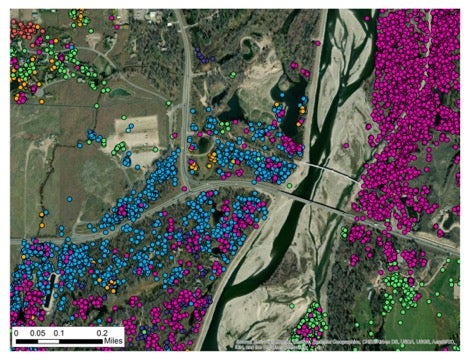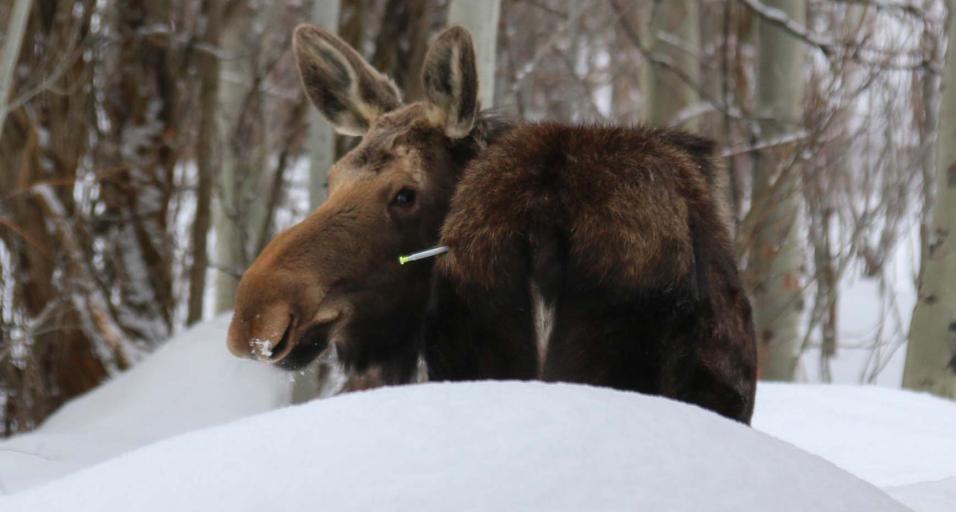Wyoming Game and Fish Department recently deployed an additional five new GPS satellite collars on cow moose in the vicinity of the Snake River Bridge on Highway 22 between Jackson and Wilson. The Wyoming Game and Fish Department and Wyoming Department of Transportation initiated the study in 2019 to learn more about when, where, and how often moose cross roads, which will in turn inform where wildlife crossings would best be located in the upcoming highway reconstruction project planned for 2022.
Last winter, there were 10 moose collared. Unfortunately, one of those moose died of unknown causes. It is known that it was not from a vehicle collision as collar data showed it had never crossed a roadway. Currently, there is a total of 14 collared moose being tracked in this area. The collars are programmed to record the location of the moose every 30 minutes for approximately 2.5 years when they will automatically detach and be recovered. While on, the collars upload GPS locations every two days to a satellite, which then sends the locations to an email account where they can be downloaded. This technology provides real-time data on moose movements and notification of possible mortalities.
This is the first time moose have been collared in this area, so a lot is being learned. For instance, in the first year, four of the 10 moose collared last winter were migratory, meaning they moved from their low elevation winter ranges where they were collared to high elevation summer ranges. One of these collared moose spent the summer some 15 miles north in Grand Teton National Park, in Open Canyon and Death Canyon. The other migratory moose spent the summer in the Phillips Canyon and Teton Pass areas.
Six of the 10 moose are considered resident, meaning they used the same general areas in both summer and winter. The resident moose primarily spent the summer on West Gros Ventre Butte, the Wilson area and along the Snake River, Fish Creek and Fall Creek.
Collared moose GPS locations in the vicinity of the Snake River Bridge and Highway 22/390 intersection from March 2019 – January 2020. Each color corresponds to an individual collared moose. The GPS collars collect a point every 30 minutes.
Movement data showed that some moose cross roads a lot, while others cross very little. Two moose only crossed Highway 22 or 390 once or twice during the first year. Other moose crossed 27, 34, and 67 times! So far, none of the collared moose have been killed by vehicle collisions, although other un-collared moose have been hit in this area.
An example of winter ticks found on an immobilized moose.
This project continues to enjoy strong community interest and support, and this year gained additional funding allowing the project objectives to be expanded to also look at impacts of winter ticks on moose as well as general health metrics like blood mineral levels, body condition and pregnancy. This work is ongoing and results will be available in the future.
Wildlife Veternarian Ginger Stout performs an ultrsound on an immobilized moose.
The Game and Fish would like to sincerely thank all of the private landowners who allowed access to their property to dart and collar moose. Gratitude is also extended to the many funding partners and collaborators: Wyoming Department of Transportation, Teton Conservation District, Greater Yellowstone Coalition, U.S. Geological Survey, Teton County, and Veterinary Initiative for Endangered Wildlife.
A cow moose's twin calves return to greet her as she recovers from being immibolized and collared.
Moose Research Expanded Near Wilson
Mark Gocke, Public Information Specialist, 307-249-5811




